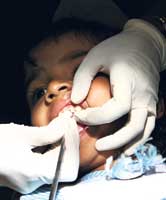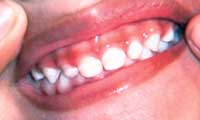Toddlers could have caries too!
By Kumudini Hettiarachchi, Pic by M.A. Pushpa Kumara.
They are only milk teeth and the common thinking is that kiri dath helenewa, because they fall off, not much attention is needed for them."This is the misconception," stresses Dr. Nazria Shahim, Consultant Dental Surgeon, Dental Public Health Unit of the Maharagama Dental Institute, explaining that the not very positive attitude towards milk teeth has resulted in inadequate attention being given to safeguarding them. "This has caused neglect of milk teeth leading to long term effects on the dental health of children."
 |
| A child undergoing a dental check-up at the clinic. |
And the major problem is dental caries which means teeth decay, MediScene learns.
It is not as if Dr. Shahim is saying this without solid evidence, for a study conducted in 2002 in Kalutara by her, covering 830 children below five years has produced data that would make many parents gnash their teeth in despair.
- 20% of the children had lesions on their teeth by the time they celebrated their first birthday. The lesions indicate that dental caries would follow soon after.
- A huge 77% of the children had dental caries by the time they reached five years of age.
In the first five years of the child's life they are hardly or never checked by dental surgeons and they are missed out by the school dental programmes because they are not in school, says Dr. Shahim.
The first milk tooth usually appears when the baby is six months old, with all 20 milk teeth erupting between the age of two and a half to three years.
Why are milk teeth
important?
- For nutrition and growth - if during the growing age when the baby is starting to take solids, the teeth are lost or are giving trouble and pain, the baby's growth will certainly be affected. This has been proven scientifically by comparing the growth of children- those having healthy teeth and others having decayed teeth.
- Speech impairment - as this is the formative age and children start speaking around this time, they can develop speech impairment.
- Appearance is affected - due to the teeth taking on streaks of brown and later, if not attended to, turning black and breaking off, the child's appearance and smile can be affected. There could be teasing by other children and the child may develop low self-esteem. The child's mental well-being could also suffer.
- Effect on permanent teeth - as the buds of the permanent teeth are getting formed between the roots of the milk teeth, if these are decayed it could seep through and affect the developing bud. The buds of the permanent teeth can get malformed and also gain a different colour and shape.
If the diseased milk tooth is infected it may have to be removed and the space created, depending on the child's age, will not remain the same as other milk teeth will drift into the gap. This can obstruct the growth of the permanent tooth. Normally, a child will begin to lose the milk teeth at around six years, but if they are affected by caries then even at three the teeth may have to be removed.
"The last of the milk teeth fall off only when the child is around 12 to 13 years old, that's why they need to be kept healthy," explains Dr. Shahim, stressing that if the milk teeth decay, the chances of the permanent teeth decaying are very high.
What are the causes of dental caries?
There are two main factors, MediScene understands
- Dental plaque - Bacteria in dental plaque (Mutans streptococci and lactobacilli) can be transmitted from mother or other close relatives to a baby through kissing, close contact and also using the same feeding instruments. After the baby's teeth erupt those with a high count of bacteria and with poor oral health are likely to develop caries.
Urging expectant mothers to see a dental surgeon to check out their teeth and attend to them, Dr. Shahim says this would help limit bacteria-transmission from mother to baby once the baby is born.
Once the baby is born, the mother is preoccupied with her newborn and will not have time for dental visits, but they should get themselves checked during pregnancy. An important factor, scientifically proven is that if the initial count of such bacteria in the baby's mouth is high, it tends to remain high throughout life.
- Sugary foods - Not only lollies and sweets but also biscuits, cream buns and bakery products with sugar all create an ideal environment in the mouth for the bacteria which cause dental caries, to thrive. The stickier the food, the more damage it can cause to the teeth, while the more frequently the child eats it, the higher chances of developing caries.
"Sticky sweets get stuck between and on the teeth, then the damage is more. The amount and frequency of sugary foods also have an effect," she says, explaining that the pH level drops when you take such food and your mouth becomes acidic but gets back to normal as the saliva has a buffering effect. But if you take such food constantly there is no time for the saliva to act and the acidic environment remains, leading to the enamel of the teeth dissolving. "There is re-mineralization of the enamel but snacking will not allow it."
Prevention is the
key, but how?
- Educating mothers is of vital importance. The lesson should be that all expectant mothers should have routine dental examinations, while also eating a healthy diet. What most mothers are unaware of is that a baby's teeth start forming long before birth, when the foetus is 5-6 weeks old.
- Preventing transmission of bacteria which cause caries by not only the mother getting dental treatment if necessary but also siblings if they are prone to dental diseases.
- Avoid feeding while the baby is asleep.
- Don't introduce sugary foods to the baby.
- Clean the baby's teeth at least twice a day, with a brush with soft bristles and a smear of toothpaste with fluoride. Cleaning practices should begin from the day the first tooth erupts. Delaying the brushing is also a contributory factor for caries.
- Lift the lip of the baby and have a look at the teeth for any tell-tale sign of caries.
"If you catch it early we can help, restore the tooth to its initial form, provided teeth-friendly behaviours are practised,” adds Dr. Shahim whose unit treats about 200 pregnant mothers and 400 children a month.
They also carry out mobile clinics and outreach programmes. For more information, please contact Phone: 2837988 ext 112.
| Don’t ignore white spot lesions |
What is the danger sign of tooth decay? How can parents detect it?
- White spot lesion - A white lesion on the teeth, which could also turn brown. This is often mistaken for stains and ignored by parents.
 This is the earliest stage and the child should be shown to a dental surgeon immediately, says Dr. Shahim. The lesions can be reversed, if there is no tissue loss or cavity formation, by the application of fluoride which is done at the Dental Therapists' Training School and the Dental Institute in Maharagama, the Dental Institute in Colombo and the Dental Faculty in Peradeniya. This is the earliest stage and the child should be shown to a dental surgeon immediately, says Dr. Shahim. The lesions can be reversed, if there is no tissue loss or cavity formation, by the application of fluoride which is done at the Dental Therapists' Training School and the Dental Institute in Maharagama, the Dental Institute in Colombo and the Dental Faculty in Peradeniya.
If there is tissue loss and a cavity which is restricted to the enamel or dentine of the tooth, a filling has to be done. But if the cavity has reached the pulp of the tooth, complications set in and something like an adult root canal filling has to be done.
"In children, we try to preserve the pulp to buy a little more time by resorting to pulp therapy. But facilities for this treatment are not widely available. It is tedious and parents will have to bring the child for many visits," she says. In the worst-case scenario, the infection could spread with abscesses being formed.
|
|


 This is the earliest stage and the child should be shown to a dental surgeon immediately, says Dr. Shahim. The lesions can be reversed, if there is no tissue loss or cavity formation, by the application of fluoride which is done at the Dental Therapists' Training School and the Dental Institute in Maharagama, the Dental Institute in Colombo and the Dental Faculty in Peradeniya.
This is the earliest stage and the child should be shown to a dental surgeon immediately, says Dr. Shahim. The lesions can be reversed, if there is no tissue loss or cavity formation, by the application of fluoride which is done at the Dental Therapists' Training School and the Dental Institute in Maharagama, the Dental Institute in Colombo and the Dental Faculty in Peradeniya.